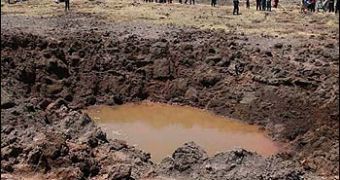No one is sure yet if it really was a meteorite, but hundreds of Peruvians have required treatment after Saturday night, an object from space crashed on Earth, in a remote area, leaving a deep crater near the town of Carancas (Andes), in the Puno area (south Peru, near the Bolivian border), some 1,300km (800 mi) south of Lima.
Those who have visited the place have been accusing symptoms such as headaches, vomiting and nausea after inhaling the gases. Three geologists from Peru's Geophysics Institute will study the site of the event to collect samples and check if it was indeed a meteorite. "It [the object] is buried in the earth", local resident Heber Mamani told the BBC. "That is why we are asking for an analysis because we are worried for our people. They are afraid. A bull is dead and some other animals are already sick," he said.
The eye witnesses of the event reported seeing a fireball in the sky plummeting towards the Earth. The remaining crater is 30m (98ft) wide and 6m (20ft) deep, and spewed fetid, noxious gases. "No radiation had been detected from the crater and the fallen object is not a satellite," Renan Ramirez, an engineer from the Peruvian Nuclear Energy Institute told the AFP news agency. "It is a conventional meteorite that, when it struck, produced gases by fusing with elements of the terrain."
The gases could have affected the health of hundreds of people who approached the site, inducing the described symptoms. Honorio Campoblanco, one of Peru's leading geologists, called on the authorities to impede people to approach the impact's site. "It is likely the dust raised when the object hit the ground is causing the health problems. A meteorite wouldn't get much gas out of the earth", said Ursula Marvin, a meteor expert at the Smithsonian Astrophysical Observatory in Massachusetts.
Similar cases were signaled in 2002 and 2004 elsewhere in southern Peru, but analyses did not confirm them as meteorites.

 14 DAY TRIAL //
14 DAY TRIAL //